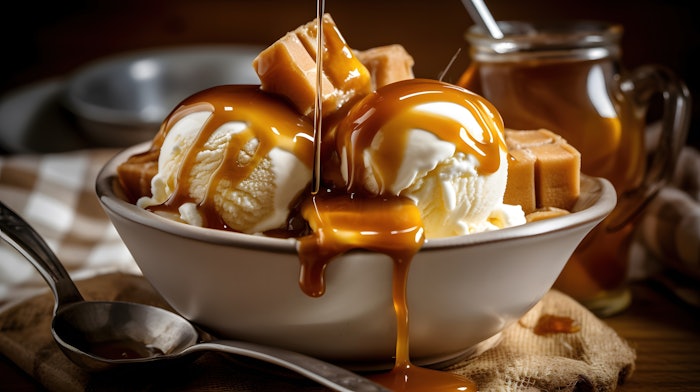
The second half of my article covers all the non-fruit applications. Stability can be an issue with furaneol in some fruit flavors, but this is generally not a significant issue in any other flavor category.
Read this article in the March 2024 issue!
Note that the dose rates given throughout this article are the levels suggested for use in flavors intended to be dosed at 0.05% in ready-to-drink beverages or a simple bouillon. The first half (covering furaneol in fruit flavors) can be found in Perfumer & Flavorist+'s February 2024 issue.
Brown Flavors
Butterscotch, Caramel and Toffee: All three related profiles can make good use of furaneol. Levels range from 1,000 ppm to 3,000 ppm.
Chocolate and Cocoa: At first sight, it might seem reasonable to use higher levels of Furaneol in chocolate flavors, but this is not the case. The ideal level in chocolate flavors is around 1,000 ppm, but the equivalent level in cocoa flavors is nearly double that.
Coffee: Similar levels of this raw material are effective in coffee flavors, adding depth and taste characteristics.
Licorice: The ideal level in licorice flavors is much lower and reflects more of an aroma effect than any level of inferred sweetness. One hundred ppm works well.
Malt: Six hundred ppm is a good starting point in malt flavors, a little higher for malted milk flavors.
Maple Syrup: Most maple syrup flavors are comfortable with a furaneol addition in the region of 1,000 ppm. This level may be lower if a more authentic profile is the objective.
Molasses and Brown Sugar: Both categories of flavors use similar levels of this raw material, typically around 1,000 ppm.
Tea: Furaneol should be used with caution in green tea flavors, but it is very helpful in black and red tea flavors at levels in the region of 500 ppm.
Vanilla, Bean: Furaneol is very effective in realistic vanilla bean flavors, adding depth and authenticity.
Nut Flavors
Almond: The ideal level of Furaneol in almond flavors depends on the degree of toast. One hundred ppm is a good starting point.
Hazelnut and Praline: Four hundred ppm works well in both hazelnut and praline flavors, adding depth and realism.
Peanut: This ingredient is most effective, within the realm of nut flavors, in peanut flavors. One thousand ppm is a good start.
Pistachio: A more moderate addition, around 200 ppm, works perfectly in pistachio flavors.
Walnut: The same 200 ppm level is also very effective in walnut flavors, counterbalancing their inherent lightness.
 A more moderate addition, around 200 ppm, works perfectly in pistachio flavors.Adobe Stock
A more moderate addition, around 200 ppm, works perfectly in pistachio flavors.Adobe Stock
Other Flavors
Beer: Furaneol is very helpful in beer flavors. The level varies quite dramatically, ranging from 100 ppm in light beer flavors up to 500 ppm in more tasty hoppy flavors.
Brandy: Furaneol is useful in spirit flavors, but only at relatively low levels. One hundred ppm is ideal in brandy and Cognac flavors.
Bread: Lightly baked bread flavors start out using around 200 ppm of this raw material. Higher levels are better in more toasted profiles, such as pizza crust.
Butter: Fresh butter flavors only need a touch of furaneol in the background, as little as 20 ppm. Cooked butter flavors are a different matter and benefit from levels as high as five hundred ppm.
Coconut: All types of coconut flavor need furaneol. The levels of addition are generally in the range of 100 ppm to 200 ppm.
Cream and Milk: Fresh cream and milk flavors are similar, in respect of furaneol, to fresh butter flavors, and only need a similarly low level.
Dough: Furaneol forms an important part of dough flavors. Levels vary but start at around 500 ppm.
Honey: Honey flavors often combine light, floral notes with a sweet background. Furaneol is very effective at rounding out the background. Levels are around 500 ppm.
 Lightly baked bread flavors start out using around 200 ppm of this raw material.Adobe Stock
Lightly baked bread flavors start out using around 200 ppm of this raw material.Adobe Stock
Milk, Condensed: Five hundred ppm is also a decent level in condensed milk and dulce de leche flavors, adding luscious background sweetness.
Rhubarb: Methyl phenyl carbonyl acetate is at the heart of most rhubarb flavors. It pairs very nicely with furaneol at around 200 ppm.
Rum: Furaneol is not an essential ingredient in rum flavors, but 20 ppm does help to balance the bright esters somewhat.
Whiskey: This ingredient is more important in whisky flavors. A modest addition, around 50 ppm, softens the background notes.
Wine: The ideal level in wine flavors depends to some extent on the type of wine that is the target, but generally falls within the range from 100 ppm to 200 ppm.










